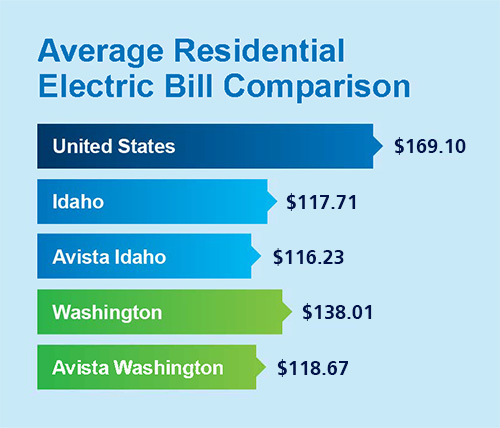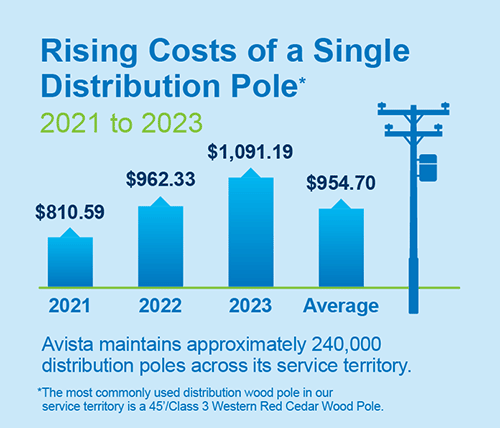About Rates
We all use energy to power our homes and businesses. But for Avista, the cost of that energy is regulated. What you see on your bill is what state utility commissions deem fair and reasonable.
How rates work
Avista customers pay an average of $3.70 a day for electricity. That’s less than 14¢ an hour to watch TV, listen to music, play video games, charge your phone, do laundry, see in the dark, or keep food fresh. Natural gas is even less expensive at under 11¢ an hour.

How do my electric rates compare nationwide?
On average, the total monthly cost of Avista’s residential electric service is 34% lower than the national average, for investor-owned utilities. See a detailed breakdown.

Where do my rate dollars go?
Equipment, maintenance, and planning. See your energy dollars at work.
Avista generates power from 8 hydroelectric projects and 7 thermal generation plants and receives power from 58 wind turbines. Then we send it over 19,000 miles of distribution lines across 30,000 square miles to more than 300,000 customers.
Maintaining and improving a massive infrastructure made up of pipes, poles, dams, turbines, and substations means that, every year, we invest hundreds of millions of dollars into our systems. It’s all part of our commitment to provide reliable energy – both now and well into the future.
Why would Avista request a rate change?
Rates can only be changed with approval from state public utility commissions. It's a carefully regulated process that typically takes several months.
Avista is an investor-owned utility, often referred to as an IOU or private utility. As an IOU, shareholders invest money that the company uses to conduct business and provide safe, reliable energy to customers. Our shareholders come from all walks of life, many also being customers of the utility. One of our shareholders might be your neighbor, co-worker, or even a family member. Operating with shareholders is a different model than other public utilities such as a public utility district (PUD), a rural electric cooperative (REA or co-op), or a municipality.
| Investor-Owned Utilities (like Avista) |
Public Utilities |
|
|---|---|---|
| Ownership |
Shareholders or investors |
A government body or customers/members of the utility |
| Rates |
Rates are set or approved and regulated by state public utility commissions through a rigorous public process that includes customer participation |
Rates are set or approved by each utility's governing body such as a board of commissioners or city council. This may include a member or public participation process. |
| Financing (where utilities get money for operations) |
Stockholders (investors), the sale of bonds and borrowing from the bank |
PUDs: Access tax-free bonds Co-ops: Access low-interest loans from the Rural Utilities Services (RUS) or National Rural Utilities Cooperative Finance Corporation |
| Generation |
Avista owns its own hydroelectric, biomass, coal and natural gas generation facilities and has contracts to purchase power, including wind power, from market suppliers. (Purchased power meets 25 percent of Avista's customer needs. |
Power is primarily purchased from the Bonneville Power Administration (BPA). Some utilities operate their own hydroelectric dams and other generation facilities. |
| Profits and net revenue |
Rates are approved by state utility commissions to recover costs and earn a reasonable return or profit for investors. |
Rates are set to recover costs and earn additional return to maintain bond ratings and invest in new facilities. |
Maintaining and improving a massive infrastructure made up of pipes, poles, dams, turbines, and substations means that, every year, we invest hundreds of millions of dollars into our system. Many parts of our system are more than 50 years old. It’s all part of our commitment to provide you with reliable energy – both now and well into the future. It’s the right thing to do.
When the rates we charge aren’t enough to cover the rising costs of facilities, equipment, damage repair, etc., we file a request with the commission to explain why our expenses are outpacing our income.
Here’s an example of the effects of rising costs on a single distribution pole:

Investing in our future
The cost of delivering safe and reliable energy includes more than one might think. It includes maintaining and improving a massive infrastructure made up of pipes, poles, dams and substations as well as technology.
Many parts of our system are more than 30, 40 or 50 years old. These expenses are part of ensuring that we can continue to provide our customers with safe, efficient and reliable power. Keeping costs affordable for customers is at the forefront of the decisions we make. We aim to save our customers money in a variety of ways, including implementing intentional purchase plans, offering natural gas for the same price we pay and continuing to be thoughtful in how we prepare our generation mix.
Even with these efforts in place, the costs to purchase power can and do fluctuate, and Avista will need to continue to invest hundreds of millions of dollars in our system every year to continue providing safe, reliable service for our customers now and into the future. This means rates will likely continue to go up.
What rates cover
Rates cover two types of costs: 1. The cost of generating or purchasing energy; 2. The cost of delivering that energy to customers. The cost of wholesale energy is a major rate-driver. Our costs fluctuate up and down based on the energy market. Avista is fortunate to own and operate the majority of the power it generates, which gives us more control over the entire energy-delivery process, from generation to transmission to distribution. This helps keep our costs to you more stable.
How rates are set
Avista is a regulated utility. That term, “regulated utility,” is important because it means that regulators set or approve our rates. It’s common to think we can raise our rates whenever we want, but in fact, the opposite is true. Avista’s rates can only be changed with approval from state public utility commissions.
- Avista Files a Rate Request - When our costs for providing energy service to our customers change, we file a rate request with the commissions to adjust rates. We must go through a detailed public process and demonstrate the need for a rate change.
- Commission Reviews Request - The commission then reviews our costs, reviews volumes of data and takes public testimony.
- Commission Sets or Approves Rates - Based on its findings, the commission sets or approves rates it believes serve the public interest - rates that are reasonable and fair to customers, while allowing Avista the opportunity to be a viable, healthy business and earn a fair return for shareholders.
Learn more about how rates are set, what they cover and how Avista compares to other investor-owned utilities across America.
Multiple filings with differing components across three states can seem confusing or complicated. To provide some clarity, we’ve defined common terms we communicate about.
- General Rate Case
Idaho, Oregon and Washington
A general rate case is the formal process through which Avista can make a request to state utility commissions to change customer base rates. Base rates are those that cover the total cost of providing electricity and natural gas service to customers. This includes generating and purchasing energy and the delivery of that energy to customers, as well as a fair return for our shareholders.
A general rate case defines base rates for customers energy use as well as the basic charge for utility service.
Through a public process, state utility commissions examine Avista's requests, take public comment and set rates that are fair and reasonable for customers and Avista. - Purchased Gas Cost Adjustment (PGE)
Idaho, Oregon and Washington
The Purchased Gas Cost Adjustment (PGA) is an annual adjustment that balances the actual cost of wholesale natural gas purchased by Avista with the amount already included in current rates - Avista does not mark up the cost of natural gas to meet customer needs. Avista is required to file the PGA each year, and costs can go up or down, based on the cost of wholesale natural gas. - Power Cost Adjustment (PCA)
Idaho
The Power Cost Adjustment (PCA) is an annual rate adjustment made to reflect certain differences between Avista's actual cost of generating and purchasing electric power to serve customers and the cost currently included in customer rates. - Residential Exchange Program
Idaho and Washington
The Bonneville Power Administration (BPA) Residential Exchange Program provides a share of the benefits of the Federal Columbia River Power System to the residential and small farm customers of the investor-owned utilities in the Pacific Northwest. We apply the benefits we receive, which typically fluctuate from year to year, to customers as a credit in their monthly electric rates. - Renewable Energy Credits ("RECs") Revenue Mechanism
Washington
The Renewable Energy Credits, or REC Revenue Mechanism, tracks and returns to customers the full level of benefits from the sale of RECs that are not otherwise used by Avista for renewable energy compliance purposes. - Energy Recovery Mechanism
Washington
The Energy Recovery Mechanism, or ERM, is a Mechanism used in Washington to track certain differences between Avista's actual cost of generating and purchasing electric power to serve customers and the cost currently included in customer rates. Adjustments in customers' rates only occur when the balance in the ERM account reaches $30 million, in either the rebate or surcharge direction. - Decoupling
Oregon and Washington
Fixed Cost Adjustment (FCA)
Idaho
Decoupling/Fixed Cost Adjustment (FCA) is a mechanism designed to break the link between a utility's revenues and a customer's energy usage.
Avista's actual revenue, based on kilowatt-hour and therm sales, will vary, up or down, from the level set by the Commission. This could be due to changes in conservation, weather or the economy.
With Decoupling/FCA, Avista's electric and natural gas revenues are adjusted each month to reflect revenues based on the number of customers, rather than kilowatt-hour and therm sales. The difference between revenues based on sales and revenue based on the number of customers will result in either surcharges or rebates to customers in the following year.
As a utility and business, Avista must bring in money to cover the expenses of providing safe, reliable energy to our customers. It’s important to understand where this money comes from and how it is spent.
Avista’s revenue comes from a variety of sources, including customers, bondholders and banks, and shareholders. Avista’s earnings, or net income, can be calculated by subtracting expenses from revenue. This net income—a fair amount determined by state regulators—goes to shareholders so that they will continue to invest in our business. A portion of net income is paid in dividends, and the remainder stays with Avista to reinvest.
As an example, think of your personal finances. Your salary comes into your home, and you must then pay your expenses such as rent/ mortgage, insurance, food, transportation, gas and more. The money that remains after paying your fixed expenses is your net income.
Executive Compensation
We understand that our customers have an interest in the salaries of our executives, especially when rates have gone up. Compensation and salaries for our executives combined account for less than one-half of one penny out of every rate dollar, which means that the average Avista customer pays around 47¢ a month for some of the best talent in the industry. (A portion of executive compensation is paid by shareholders, and the portion paid by customers is reviewed by state regulators.) Avista, along with its Board of Directors, has processes and oversight in place to set executive salaries that are:
- competitive within the marketplace
- tied to executive performance
The amount included in rates that goes to salaries is reviewed by state public utility commissions to ensure they are reasonable. The Board of Directors regularly engages an independent company to provide salary information about comparable executive positions at similar utilities. The recommended salaries are targeted to be competitive within the marketplace to help ensure that we can retain top talent and leadership.
Speaker 1: It's a product you almost never think about but you count on it 24 hours a day, seven days a week: energy. Flip the switch, the lights go on. Turn on the gas, now you're cooking. It's our job at Avista to deliver that energy safely and reliably every day. You may have heard about a rate case we filed and wondered: so what is a rate case anyway?
A rate case is the way we request to change prices or rates to recover our cost of delivering your electricity and natural gas. We're regulated by three state utility commissions, so before we can adjust our prices we must make the case that current rates are not sufficient to cover our costs. That's different from the way most companies operate. When costs change for, say, a gas station owner, he simply adjusts his price for a gallon of gas, sometimes even on a daily basis. But because we're regulated, we can't change prices whenever we see the need. We must first file a rate case to explain why our expenses are outpacing our income.
While we work hard to keep those expenses down, the cost of delivering energy continues to go up, costs like all the equipment and people it takes to maintain thousands of miles of pipes and wires, or repairing damages and restoring service after storm outages, or investing in upgrading and optimizing our system. It can add up to millions of dollars every year.
As part of this process, we conduct extensive analysis and provide thousands of pages of documents to regulators and other parties when we file a rate case. Depending on the state, regulators have between seven and 11 months to review the details and make a final ruling, setting rates that are fair and reasonable both for customers and for Avista.
It takes a lot to deliver the electricity and natural gas you rely on every day. Now, if you hear about a rate case, you'll know the role it plays in delivering that energy. You can be sure the next time you flip the switch or turn on the gas, it will be there.

